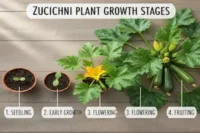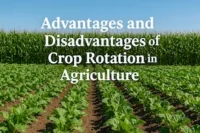Advantages and Disadvantages of Weeds in Agriculture
Published: 11 Oct 2025
Weeds are unwanted plants that grow in fields along with crops. They are often seen as a problem, but not all their effects are bad. Some weeds can even help improve soil and support farm life. Understanding both the advantages and disadvantages of weeds in agriculture helps farmers make better decisions for healthy crops. In this article, you’ll learn how weeds affect farming, when they can be useful, and why managing them the right way is so important.
What Are Weeds?
Weeds are unwanted plants that grow naturally among crops. They use the same soil, water, and sunlight that the main crops need to grow. Some weeds grow very fast and spread easily across fields. While most farmers see them as a problem, not all weeds are bad. A few can even help improve soil health and attract useful insects.
Advantages of Weeds in Agriculture
Weeds may seem harmful, but they can offer several hidden benefits to farms and gardens. Some types help protect the soil, attract helpful insects, and even improve soil fertility. When managed properly, weeds can support healthy plant growth and reduce erosion.
Here are some main advantages of weeds in agriculture:
- Soil Protection
- Improved Soil Fertility
- Habitat for Beneficial Insects
- Indicator of Soil Health
- Natural Mulch
- Adds Organic Matter
- Protects Young Crops
- Reduces Water Runoff
- Supports Biodiversity
- Useful as Green Manure
Let’s learn how weeds play an important role in agriculture.
1. Soil Protection
Weeds cover the ground and protect it from wind and rain. Their roots hold the soil tightly, stopping it from washing or blowing away. This keeps the topsoil healthy and rich in nutrients. It also helps farmers reduce soil loss during heavy rains.
- Prevents soil erosion
- Keeps topsoil fertile
- Reduces damage from strong winds
2. Improved Soil Fertility
When weeds die and decompose, they return nutrients to the soil. This natural process adds organic matter and improves soil texture. It helps crops grow better without always depending on chemical fertilizers. The soil becomes more fertile and balanced over time.
- Adds natural nutrients
- Reduces fertilizer use
- Builds long-term soil health
3. Habitat for Beneficial Insects
Weeds provide shelter and food for helpful insects like bees and ladybugs. These insects pollinate crops and eat harmful pests. A small number of weeds in or near fields can support this natural balance. Farmers benefit from needing fewer pesticides.
- Supports natural pollination
- Controls harmful pests
- Reduces pesticide need
4. Indicator of Soil Health
Certain weeds grow only under specific soil conditions. Their presence can tell farmers if the soil is dry, compact, or lacks nutrients. This helps farmers understand what their land needs. It’s a simple, natural way to check soil health without tools.
- Helps identify soil problems
- Guides fertilizer use
- Saves time and testing costs
5. Natural Mulch
Weeds act as a living cover over the soil. They help keep the ground cool and reduce water loss. The shade they create also stops other unwanted weeds from growing too fast. This natural mulch supports better moisture levels for crops.
- Maintains soil moisture
- Reduces water evaporation
- Slows unwanted weed growth
6. Adds Organic Matter
When weeds are mixed back into the soil, they add organic materials that improve structure. This helps the soil hold water and air better. It also supports the growth of useful microbes. Over time, it leads to healthier and more productive farmland.
- Improves soil structure
- Increases water-holding capacity
- Supports soil microbes
7. Protects Young Crops
Some weeds provide light shade for tender seedlings. This helps protect them from the hot sun and strong winds. The extra cover allows young plants to grow safely until they are strong enough. It’s a natural way to support early crop growth.
- Shields seedlings from heat
- Reduces plant stress
- Encourages steady growth
8. Reduces Water Runoff
Thick weed growth slows the flow of rainwater over the ground. This allows more water to soak into the soil instead of washing away. As a result, crops get better access to moisture. It also helps reduce flooding and soil loss.
- Increases water absorption
- Reduces soil erosion
- Helps prevent water loss
9. Supports Biodiversity
Weeds attract many living creatures like insects, birds, and small animals. These creatures help create a balanced farm ecosystem. A diverse environment improves pollination and pest control naturally. It makes the farm more stable and sustainable.
- Encourages natural balance
- Promotes pollination
- Strengthens farm ecosystems
10. Useful as Green Manure
Some weeds can be turned into the soil as green manure. This adds nutrients quickly and improves soil health. It’s a cost-free, natural way to enrich farmlands. Many farmers use this method between crop seasons.
- Boosts soil nutrients
- Cuts fertilizer costs
- Improves soil texture naturally
Helpful vs. Harmful Weeds (Comparison Chart)
| Helpful Weeds 🌱 | Harmful Weeds 🌾 |
| Protect soil from erosion by covering bare ground | Steal nutrients, water, and sunlight from crops |
| Add organic matter when it decomposes into the soil | Reduce crop yield and quality over time |
| Attract pollinators like bees and butterflies | Host pests and plant diseases that harm crops |
| Improve soil structure and fertility naturally | Increase farming costs due to weeding and herbicides |
| Act as a natural mulch to keep the soil moist | Block irrigation and drainage systems |
| Serve as food or medicine in some cases | Release chemicals (allelopathy) that slow crop growth |
| Provide shade and shelter for young plants | Spread fast and are hard to remove once they grow |
| Indicate soil condition (nutrient-rich or poor) | Affect the seed germination of nearby crops |
| Support biodiversity by giving habitat to insects | Causes harvesting problems by tangling with crops |
| Spread fast and are hard to remove once they grow | Spread fast and are hard to remove once grow |
Disadvantages of Weeds in Agriculture
Weeds can create many problems for farmers and crops. They compete with main plants for sunlight, water, and soil nutrients. Some weeds also spread diseases and attract harmful insects. If not managed, they can lower crop yield and reduce overall farm quality.
Major Disadvantages:
- Compete with crops for nutrients, water, and sunlight
- Reduce crop yield and quality
- Increase farming costs due to extra weeding work
- Serve as hosts for pests and plant diseases
- Make harvesting more difficult and time-consuming
- Decrease the value of farm products
- Release chemicals that harm crop growth (allelopathy)
- Spread quickly and become hard to control
- Block irrigation channels and drainage systems
- Affect the germination of young crops
1. Compete with Crops for Nutrients, Water, and Sunlight
Weeds grow fast and take the same resources that crops need. They absorb soil nutrients before the main plants can. This makes crops weaker and less productive. In dry areas, weeds also take most of the water, leaving little for crops.
- Reduce nutrient availability for crops
- Slow down crop growth
- Causes uneven plant development
2. Reduce Crop Yield and Quality
When weeds grow thickly, they crowd out crops and block sunlight. This stress leads to smaller fruits, grains, or vegetables. Weeds also reduce the size and quality of the harvest. Farmers may get less profit from their crops.
- Lower overall yield
- Decrease the market value of produce
- Increase losses for farmers
3. Increase Farming Costs
Farmers must spend more money and time removing weeds. This includes using herbicides, hiring labor, or buying tools. Regular weeding increases production costs and effort. The extra expense affects farm income.
- More labor is needed for the wedding
- Higher chemical costs
- Greater time investment
4. Serve as Hosts for Pests and Plant Diseases
Many weeds attract insects and diseases that harm crops. They provide shelter for pests during the off-season. These pests later attack the main plants. This increases the risk of infections and crop loss.
- Attract harmful insects
- Spread plant diseases
- Damage healthy crops
5. Make Harvesting More Difficult and Time-Consuming
Weeds that grow tall or dense can cover crop rows. This makes harvesting hard and slow. Machines may get clogged or damaged by thick weeds. Manual harvesting also becomes tiring and slow.
- Slows down the harvest process
- Increases labor time
- Raises equipment wear and tear
6. Decrease the Value of Farm Products
Weeds can mix with harvested crops and lower their quality. Buyers may reject or pay less for mixed produce. This reduces the farm’s overall income. Clean crops are always more valuable than weedy ones.
- Reduces market price
- Affects crop appearance
- Leads to buyer dissatisfaction
7. Release Chemicals That Harm Crop Growth (Allelopathy)
Some weeds produce natural chemicals that slow the growth of nearby plants. These chemicals affect seed germination and root development. As a result, crops may grow weak or fail to sprout. This natural effect is called allelopathy.
- Blocks seed germination
- Reduces plant strength
- Causes uneven field growth
8. Spread Quickly and Become Hard to Control
Weeds grow and reproduce very fast. A few plants can spread seeds across a whole field in a short time. Once they spread, controlling them becomes difficult. They often return even after removal.
- Spread through wind, animals, or water
- Regrow after cutting or spraying
- Take over crop fields easily
9. Block Irrigation Channels and Drainage Systems
Weeds growing in ditches or canals can block water flow. This leads to poor irrigation and waterlogging in fields. Crops may suffer from too little or too much water. It also requires extra cleaning work.
- Block the proper water supply
- Causes waterlogging or dryness
- Need regular channel maintenance
10. Affect Germination of Young Crops
Weeds near young plants create too much shade and compete for food. The seedlings can’t get enough light or nutrients to grow. This weakens their early development. Fewer healthy plants reach maturity.
- Reduce seedling growth
- Lower survival rate of young crops
- Delay overall crop maturity
Types of Weeds Found in Agriculture
Weeds come in many types, and knowing them helps farmers manage their fields better. Here are some common kinds found in farms and gardens:
- Broadleaf Weeds: These have wide leaves and deep roots. Examples include pigweed, dandelion, and chickweed. They compete strongly for nutrients but are easy to pull out.
- Grassy Weeds: These look like grass and grow quickly. Common types are crabgrass, Bermuda grass, and foxtail. They spread fast and often mix with crop plants.
- Sedge Weeds: These have solid stems and love wet soil. Examples include nutgrass and yellow sedge. They’re tough to control once they spread.
- Perennial Weeds: These grow year after year and are very hard to remove. Examples include couch grass and bindweed. Their roots stay alive even after being cut.
Understanding these weed types helps farmers decide which control method to use for each kind.
Weed Management Methods
Managing weeds the right way keeps crops healthy and fields productive. Here are some simple and effective weed control methods farmers often use:
- Manual Weeding: Pulling weeds by hand or using simple tools like hoes. It’s best for small gardens and early-stage crops.
- Mulching: Covering the soil with straw, leaves, or plastic sheets to block sunlight and stop weed growth.
- Crop Rotation: Growing different crops in each season to break the life cycle of certain weeds.
- Organic Control: Using vinegar sprays, saltwater, or natural herbicides instead of strong chemicals.
- Cover Crops: Planting crops like clover or rye between growing seasons to naturally block weeds.
A mix of these methods keeps weeds in control without harming the soil or environment. Learn more about soil-friendly practices in our post on Advantages of Crop Rotation in Agriculture.
Environmental Role of Weeds
Even though weeds can trouble farmers, they also play a small part in nature’s balance. Their roots hold the soil in place, reducing erosion after heavy rain or wind. Some weeds add organic matter when they die, helping soil stay rich and loose. They also provide food and shelter for birds, insects, and other small animals. So, weeds are not always enemies — sometimes, they quietly help the farm ecosystem.
Advantages and Disadvantages of Weeds
Here is a list of the benefits and drawbacks of weeds in agriculture.
| Advantages of Weeds |
|---|
|
| Disadvantages of Weeds in Agriculture |
|---|
|
Quick Facts
Here is a list of quick facts about weeds in agriculture.
- Not all weeds are bad. Some actually help protect the soil and keep it healthy.
- A few common weeds can turn into natural fertilizers when mixed back into the soil.
- Bees and butterflies love weed flowers, which means more pollination for nearby crops.
- Weeds can show what your soil needs like more water, air, or nutrients.
- But if left unchecked, weeds can steal food and sunlight from your crops.
- Smart farmers know the trick: control weeds, don’t destroy them all!
Helpful Tips: Pros and Cons of Weeds in Agriculture
- Observe your field closely. Notice which weeds grow — they often tell you a lot about your soil condition.
- Don’t rush to remove all weeds. Some can protect your soil or attract helpful insects.
- Keep balance in mind. Allow a few harmless weeds but control those that spread too fast.
- Use weeds wisely. Turn them into compost or green manure instead of throwing them away.
- Learn weed types. Knowing which ones are good or bad helps you manage them better.
- Stay consistent. Regular checking and gentle control keep your field healthy and productive.
Conclusion:
Weeds can be both helpful and harmful in farming. They protect the soil, attract insects, and add nutrients, but they also compete with crops and lower yield. Knowing the advantages and disadvantages of weeds in agriculture helps farmers make smarter choices. Think smart before choosing how to manage weeds on your farm! If you like learning about pros and cons in farming, check out Advantages and Disadvantages of Rooftop Gardening
FAQs about the Benefits and Drawbacks of Weeds in Agriculture.
Here are frequently asked questions about the pros and cons of weeds in agriculture.
Weeds help protect soil by reducing erosion; their roots hold soil in place. Some weeds decompose and add organic matter, which feeds soil microbes and improves texture. Certain weed types indicate when the soil lacks nutrients or has pH problems. All these help farmers understand and improve their land.
Weeds compete with crops for water, sunlight, and nutrients, and thus weaken crop growth. They can make crops smaller or slow their development. Diseases and pests often use weeds as hiding places or hosts, spreading into the main crop. Over time, heavy weed pressure can greatly reduce the harvest.
Yes, in certain situations. If weeds are used as green manure (turned into soil) they add nutrients, reducing the need for chemical fertilizers. Some weeds provide cover that reduces water loss in dry spells, saving irrigation costs. But this only works when weed growth is managed and kept moderate.
Keeping weeds under control needs labor or machinery, both of which cost money. Many farmers use herbicides, which are expensive and often require repeated applications. Also, when weeds contaminate harvested grain or crops, extra cleaning and sorting are needed. These added tasks all increase overall farm expenses.
Definitely. Some weeds serve as animal fodder, though the quality varies. Others are edible or have medicinal uses when properly identified and prepared. Some weeds also help attract beneficial insects or act as a habitat, which can help with natural pest control. So, they can be more than just nuisances.

- Be Respectful
- Stay Relevant
- Stay Positive
- True Feedback
- Encourage Discussion
- Avoid Spamming
- No Fake News
- Don't Copy-Paste
- No Personal Attacks



- Be Respectful
- Stay Relevant
- Stay Positive
- True Feedback
- Encourage Discussion
- Avoid Spamming
- No Fake News
- Don't Copy-Paste
- No Personal Attacks



